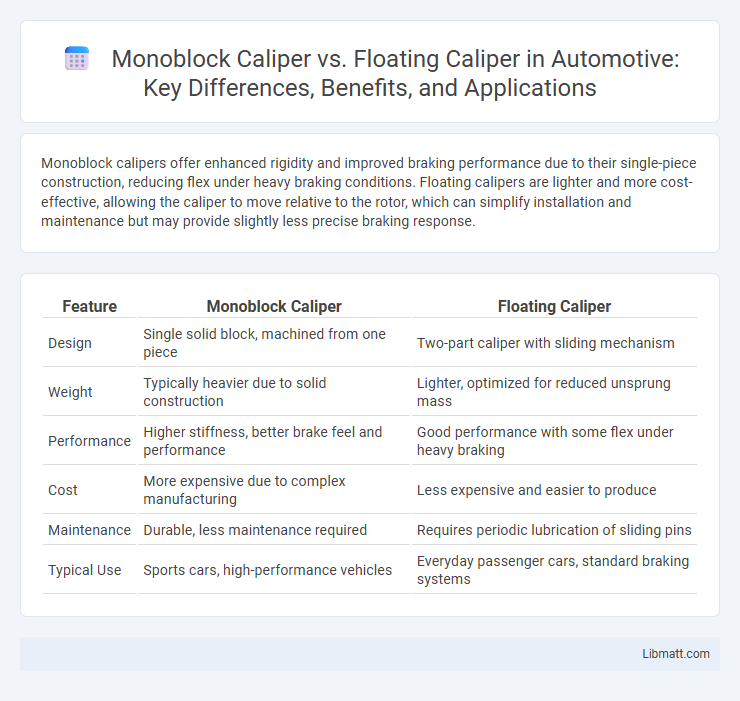Monoblock calipers offer enhanced rigidity and improved braking performance due to their single-piece construction, reducing flex under heavy braking conditions. Floating calipers are lighter and more cost-effective, allowing the caliper to move relative to the rotor, which can simplify installation and maintenance but may provide slightly less precise braking response.
Table of Comparison
| Feature | Monoblock Caliper | Floating Caliper |
|---|---|---|
| Design | Single solid block, machined from one piece | Two-part caliper with sliding mechanism |
| Weight | Typically heavier due to solid construction | Lighter, optimized for reduced unsprung mass |
| Performance | Higher stiffness, better brake feel and performance | Good performance with some flex under heavy braking |
| Cost | More expensive due to complex manufacturing | Less expensive and easier to produce |
| Maintenance | Durable, less maintenance required | Requires periodic lubrication of sliding pins |
| Typical Use | Sports cars, high-performance vehicles | Everyday passenger cars, standard braking systems |
Introduction to Brake Calipers
Monoblock calipers are machined from a single piece of aluminum, providing enhanced rigidity and improved braking performance due to reduced flex. Floating calipers, also known as sliding calipers, consist of multiple parts that move relative to each other, allowing them to adjust to rotor wear but potentially introducing slight flex under heavy braking. Your choice between monoblock and floating calipers impacts braking efficiency, heat dissipation, and overall vehicle control.
What is a Monoblock Caliper?
A monoblock caliper is a type of brake caliper machined from a single solid piece of metal, enhancing rigidity and reducing flex under extreme braking conditions. This design improves braking performance by providing more precise and consistent pressure on the brake pads compared to floating calipers. Commonly used in high-performance and racing vehicles, monoblock calipers offer better heat dissipation and durability for demanding driving environments.
What is a Floating Caliper?
A floating caliper is a type of brake caliper that moves laterally relative to the rotor, using one or two pistons on only one side of the rotor to clamp the brake pads. This design allows the caliper to "float" and self-center over the rotor, offering effective braking performance with simpler construction and generally lower cost. Understanding the floating caliper's operation helps you choose the right brake system for your vehicle's performance and maintenance needs.
Design Differences: Monoblock vs Floating Calipers
Monoblock calipers are crafted from a single piece of metal, offering enhanced rigidity and improved braking performance due to reduced flex during heavy braking. Floating calipers, in contrast, feature a two-piece design where the caliper body moves laterally on pins, allowing self-centering over the rotor but generally providing less stiffness. Your choice between monoblock and floating calipers directly impacts brake responsiveness and durability, with monoblock calipers typically favored for high-performance applications.
Performance Comparison
Monoblock calipers offer superior rigidity and enhanced braking performance due to their single-piece construction, resulting in better pedal feel and reduced flex during high-stress conditions. Floating calipers, while lighter and more cost-effective, may experience slight flex and less consistent brake pad contact, affecting overall stopping power. The monoblock design provides improved heat dissipation and stability, making it ideal for high-performance and racing applications.
Durability and Maintenance
Monoblock calipers offer superior durability due to their single-piece construction, reducing flex and enhancing braking performance under high stress. Floating calipers are generally easier to maintain and replace since their components are modular, but they may experience more wear over time because of the sliding mechanism. Choosing a monoblock caliper ensures longer-lasting reliability, though Your maintenance routine might be simpler with floating calipers.
Weight and Material Considerations
Monoblock calipers are typically made from a single piece of lightweight aluminum alloy, which enhances rigidity and reduces unsprung weight for improved braking performance. Floating calipers often use cast iron or mixed materials, resulting in increased weight but more cost-effective manufacturing. Your choice between them can influence the overall weight balance and heat dissipation efficiency of your braking system.
Cost Analysis
Monoblock calipers generally have a higher manufacturing cost due to their single-piece design, which requires precision machining and superior materials for increased rigidity and performance. Floating calipers are typically more cost-effective, employing a simpler, two-piece construction that reduces production complexity and material expenses. Cost analysis favors floating calipers for budget-sensitive applications, while monoblock calipers justify their premium price with enhanced durability and performance in high-stress environments.
Best Applications for Each Type
Monoblock calipers, known for their rigid, single-piece construction, excel in high-performance applications such as racing and heavy-duty braking scenarios where precision and reduced flex are critical. Floating calipers, featuring a sliding mechanism, are best suited for everyday street vehicles and lighter braking tasks due to their cost-effectiveness, ease of maintenance, and ability to self-adjust for even pad wear. Choosing the right caliper depends on the vehicle's performance requirements and typical driving conditions, with monoblocks offering superior stiffness and heat dissipation for aggressive driving, while floating calipers provide reliable braking for standard use.
Which Caliper is Right for You?
Monoblock calipers offer superior rigidity and heat dissipation, making them ideal for high-performance or track use where consistent braking is crucial. Floating calipers provide a more cost-effective, lightweight solution suitable for everyday driving and moderate braking demands. Choosing between them depends on your vehicle's performance needs and budget constraints.
monoblock caliper vs floating caliper Infographic

 libmatt.com
libmatt.com